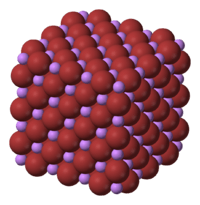Lithium bromide
 | |
| Names | |
|---|---|
| IUPAC name
Lithium bromide | |
| Identifiers | |
| 7550-35-8 | |
| 3D model (Jmol) | Interactive image |
| ChemSpider | 74049 |
| ECHA InfoCard | 100.028.582 |
| EC Number | 231-439-8 |
| PubChem | 82050 |
| RTECS number | OJ5755000 |
| UNII | 864G646I84 |
| |
| |
| Properties | |
| LiBr | |
| Molar mass | 86.845(3) g/mol |
| Appearance | White solid hygroscopic |
| Density | 3.464 g/cm3 |
| Melting point | 552 °C (1,026 °F; 825 K) |
| Boiling point | 1,265 °C (2,309 °F; 1,538 K) |
| 143 g/100 mL (0 °C) 166.7 g/100 mL (20 °C) 266 g/100 mL (100 °C) | |
| Solubility | soluble in methanol, ethanol, ether, acetone slightly soluble in pyridine |
| Refractive index (nD) |
1.784 |
| Thermochemistry | |
| 51.88 J/mol K | |
| Std molar entropy (S |
66.9 J/mol K |
| Std enthalpy of formation (ΔfH |
-350.3 kJ/mol |
| Gibbs free energy (ΔfG˚) |
-338.9 kJ/mol |
| Std enthalpy of combustion (ΔcH |
-157 kJ/mol |
| Hazards | |
| NFPA 704 | |
| Flash point | Not-flammable |
| Lethal dose or concentration (LD, LC): | |
| LD50 (median dose) |
1800 mg/kg (oral, rat)[1] |
| Related compounds | |
| Other anions |
Lithium fluoride Lithium chloride Lithium iodide Lithium astatide |
| Other cations |
Sodium bromide Potassium bromide Rubidium bromide Caesium bromide Francium bromide |
| Except where otherwise noted, data are given for materials in their standard state (at 25 °C [77 °F], 100 kPa). | |
| | |
| Infobox references | |
Lithium bromide (LiBr) is a chemical compound of lithium and bromine. Its extreme hygroscopic character makes LiBr useful as a desiccant in certain air conditioning systems.[2]
Production and properties
LiBr is prepared by treatment of lithium carbonate with hydrobromic acid. The salt forms several crystalline hydrates, unlike the other alkali metal bromides.[3] The anhydrous salt forms cubic crystals similar to common salt (sodium chloride).
Lithium hydroxide and hydrobromic acid (aqueous solution of hydrogen bromide) will precipitate lithium bromide in the presence of water.
LiOH + HBr → LiBr + H2O
Uses
Lithium bromide is used in air-conditioning systems as desiccant.
Lithium bromide is used as a salt in absorption chilling along with water (see absorption refrigerator).
Otherwise the salt is useful as a reagent in organic synthesis. For example, it reversibly forms adducts with some pharmaceuticals.[2]
Medical applications
Lithium bromide was used as a sedative, beginning in the early 1900s, but it fell into disfavor in the 1940s when some heart patients died after using it as a salt substitute.[4]
Like lithium carbonate and lithium chloride, it was used as treatment for bipolar disorder.
Doses as low as 225 mg/day of LiBr can lead to bromism.
Hazards
Lithium salts are psychoactive and somewhat corrosive. Heat is quickly generated when lithium bromide is dissolved into water because it has a negative enthalpy of solution.
References
- ↑ http://chem.sis.nlm.nih.gov/chemidplus/rn/7550-35-8
- 1 2 Ulrich Wietelmann, Richard J. Bauer "Lithium and Lithium Compounds" in Ullmann's Encyclopedia of Industrial Chemistry 2005, Wiley-VCH: Weinheim.
- ↑ Holleman, A. F.; Wiberg, E. (2001), Inorganic Chemistry, San Diego: Academic Press, ISBN 0-12-352651-5
- ↑ Bipolar disorder
External links
- "A PDF file from GFS Chemicals, a supplier of lithium bromide" (PDF). Retrieved 2005-09-15.
